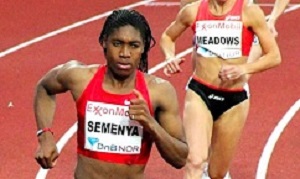In a robust new study with dire implications for trans athletes like SA's Caster Semenya, researchers at the Karolinska Institutet and the Swedish School of Sport and Health Sciences found a significant causal relationship between elevated male sex hormone levels and increased aerobic capacity in young women, writes MedicalBrief. There was also an increase in muscle mass but not muscle strength.
The findings come as the International Association of Athletics Foundations (IAAF) on Monday, October 13, 2019, announced an upper limit for testosterone levels on trans female athletes competing in middle-distance events.
“These are expected results to some extent, but the fact that there is now a scientific study is relevant to the discussion regarding the regulations for hyperandrogenism in female athletes,” says Angelica Lindén Hirschberg, gynaecologist and professor at the department women’s and children’s health, Karolinska Institutet, Sweden, who has been in charge of this study.
A current example where hyperandrogenism has been discussed within the sporting world is the case of the South African Olympic medallist Caster Semenya, who needs to lower her testosterone levels to be able to participate in middle distance events at the World Athletics Championships.
Testosterone was assumed to be performance-enhancing and a factor in explaining differences in strength and endurance between men and women. However, there was a surprising lack of evidence on the impact of testosterone in women and the question had become mired in controversy following a series of rulings in professional sport, reports The Guardian.
Professor Chris Cooper, emeritus professor of biochemistry at the University of Essex, who was not involved in the work, said: “The data is really clear. This adds further evidence that if you give testosterone to female athletes. you improve their performance. Some people have suggested that testosterone is not the only sex difference, but it’s clearly the best indicator.”
The IAAF ruled this week that trans female athletes must keep their levels of natural testosterone below 5 nanomoles per litre of blood to compete in the female category. The new regulation follows a similar limit imposed on athletes with differences of sexual development (DSD), including Semenya.
Semenya is challenging the IAAF’s new rules that athletes with DSD must take testosterone-reducing medication to compete in track events from 400m to the mile or change to another distance.
She argued that the rules were discriminatory and unfair. The Court of Arbitration for Sport in May found that the rules for athletes with DSD were discriminatory, but that the discrimination was “necessary, reasonable and proportionate” to protect “the integrity of female athletics”.
The new published study involved 48 physically active women aged between 18 and 35, who were randomly administered either a 10 mg supplementation of testosterone per day or a placebo over a period of ten weeks. Neither the participants nor those administering the substance were aware of who received the testosterone and who was given the placebo. The study, which was conducted in 2018, was completed by all participants. The researchers then measured the women’s aerobic capacity (fitness test on a treadmill), their anaerobic capacity (exercise stress test on a bike), and muscle strength using various tests.
The results show that 10 weeks of moderately elevated testosterone concentration caused a significant increase in aerobic capacity in comparison with the placebo. Secondary outcome measurements such as anaerobic performance tended to increase, while the jump test and muscle strength were not affected despite the fact that muscle mass increased significantly with testosterone exposure compared with the placebo.
Overall, the researchers conclude that the study supports a causal relationship between testosterone and an increase in physical performance and muscle mass in young women.
The research was funded with grants from the International Athletics Foundation, the Swedish Research Council, the Swedish Research Council for Sport Science, and Karolinska Institutet. The pharmaceutical company Lawley Pharmaceuticals provided the testosterone treatment and placebo. Angelica Lindén Hirschberg is a medical and scientific consultant for the Swedish Olympic Committee as well as the International Association of Athletics Federations (IAAF) and the International Olympic Committee (IOC) regarding hyperandrogenism and transsexualism in female athletes.
Abstract
Objective: To investigate the effects of a moderate increase in serum testosterone on physical performance in young, physically active, healthy women.
Methods: A double blind, randomised, placebo controlled trial was conducted between May 2017 and June 2018 (ClinicalTrials.gov ID: NCT03210558). 48 healthy, physically active women aged 18–35 years were randomised to 10 weeks of treatment with 10 mg of testosterone cream daily or placebo (1:1). All participants completed the study. The primary outcome measure was aerobic performance measured by running time to exhaustion (TTE). Secondary outcomes were anaerobic performance (Wingate test) and muscle strength (squat jump (SJ), counter movement jump (CMJ) and knee extension peak torque). Hormone levels were analysed and body composition assessed by dual energy X-ray absorptiometry.
Results: Serum levels of testosterone increased from 0.9 (0.4) nmol/L to 4.3 (2.8) nmol/L in the testosterone supplemented group. TTE increased significantly by 21.17 s (8.5%) in the testosterone group compared with the placebo group (mean difference 15.5 s; P=0.045). Wingate average power, which increased by 15.2 W in the testosterone group compared with 3.2 W in the placebo group, was not significantly different between the groups (P=0.084). There were no significant changes in CMJ, SJ and knee extension. Mean change from baseline in total lean mass was 923 g for the testosterone group and 135 g for the placebo group (P=0.040). Mean change in lean mass in the lower limbs was 398 g and 91 g, respectively (P=0.041).
Conclusion: The study supports a causal effect of testosterone in the increase in aerobic running time as well as lean mass in young, physically active women.
Authors
Angelica Lindén Hirschberg, Jona Elings Knutsson, Torbjörn Helge, Manne Godhe, Maria Ekblom, Stephane Bermon, Björn Ekblom
[link url="https://news.ki.se/increased-performance-in-female-athletes-after-testosterone-supplementation"]Karolinska Institutet material[/link]
[link url="https://bjsm.bmj.com/content/early/2019/09/26/bjsports-2018-100525"]British Journal of Sports Medicine abstract[/link]
[link url="https://www.theguardian.com/science/2019/oct/15/testosterone-boosts-womens-athletic-performance-study-shows"]The Guardian report[/link]

